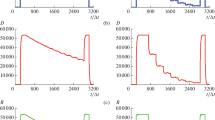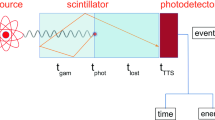Abstract
Detectors with continuous scintillator and matrix of photomultipliers attached are widely used in modern particle physics and various medical tomographs. There are two common ways to calculate the coordinates of the scintillation flash via photomultipliers energy outcome: Anger’s method and Monte Carlo simulations. In this article, we derive an analytical solution for the computation of the energy outcome from several photomultipliers built into the bottom face of the scintillation camera with a continuous scintillator shaped as a rectangular parallelepiped. The lateral faces of the scintillation camera are considered specular reflectors with reflective indexes \(\sim 1\) or 0. The analytical solution is used as a reference point for the scintillation flash coordinate reconstruction. The achieved results are similar to those the Monte Carlo simulation provides, but require less computational time.
















Similar content being viewed by others
Data availability
No data are associated in the manuscript.
References
S. Basu, A. Alavi, SPECT-CT and PET-CT in oncology-an overview. Curr. Med. Imaging 7, 202–209 (2011)
P. Moskal et al., Time resolution of the plastic scintillator strips with matrix photomultiplier readout for J-PET tomograph. Phys. Med. Biol. 61, 2025 (2016)
P. Moskal et al., Simulating NEMA characteristics of the modular total-body J-PET scanner–an economic total-body PET from plastic scintillators. Phys. Med. Biol. 66, 175015 (2021)
P. Beltrame et al., The AX-PET demonstrator–design, construction and characterization. Nucl. Instrum. Methods Phys. Res., Sect. A Accel. Spectrom. Detect. Assoc. Equip. 654, 546–559 (2011)
S. Vandenberghe, P. Moskal, J.S. Karp, State of the art in total body PET. EJNMMI Phys. 7, 1–33 (2020)
X. Zhang, J. Zhou, S.R. Cherry, R.D. Badawi, J. Qi, Quantitative image reconstruction for total-body PET imaging using the 2-meter long EXPLORER scanner. Phys. Med. Biol. 62, 2465 (2017)
S.R. Cherry et al., Total-body PET: maximizing sensitivity to create new opportunities for clinical research and patient care. J. Nucl. Med. 59, 3–12 (2018)
M.T. Madsen, Recent advances in SPECT imaging. J. Nucl. Med. 48, 661–673 (2007)
M.M. Khalil, J.L. Tremoleda, T.B. Bayomy, W. Gsell, Molecular SPECT imaging: an overview. Int. J. Mol. Imaging 2011, 796025 (2011)
D.L. Bailey, K.P. Willowson, An evidence-based review of quantitative SPECT imaging and potential clinical applications. J. Nucl. Med. 54, 83–89 (2013)
A.J. González, et al. Continuous or pixelated scintillators?, not longer a discussion, in 2014 IEEE Nuclear Science Symposium and Medical Imaging Conference (NSS/MIC), 1–4 (2014)
H.O. Anger, Sensitivity, resolution, and linearity of the scintillation camera. IEEE Trans. Nucl. Sci. 13, 380–392 (1966)
T.D. Milster et al., A modular scintillation camera for use in nuclear medicine. IEEE Trans. Nucl. Sci. 31, 578–580 (1984)
C. Fiorini et al., The \({\rm HICAM}\) gamma camera. IEEE Trans. Nucl. Sci. 59, 537–544 (2012)
T. Peterson, L. Furenlid, SPECT detectors: the Anger camera and beyond. Phys. Med. Biol. 56, R145-82 (2011)
M. Kim et al., Design of a scintillator-based prompt gamma camera for boron-neutron capture therapy: comparison of SrI2 and GAGG using Monte-Carlo simulation. Nucl. Eng. Technol. 53, 626–636 (2021)
A. Morozov et al., Iterative reconstruction of detector response of an Anger gamma camera. Phys. Med. Biol. 60, 4169 (2015)
M. Korevaar, M. Goorden, J. Heemskerk, F. Beekman, Maximum-likelihood scintillation detection for EM-CCD based gamma cameras. Phys. Med. Biol. 56, 4785–801 (2011)
F. Acerbi, S. Gundacker, Understanding and simulating SiPMs. Nucl. Instrum. Methods Phys. Res., Sect. A Accel. Spectrom. Detect. Assoc. Equip. 926, 16–35 (2019)
F. Pedrotti, L. Pedrotti, Introduction to Optics ISBN: 9780135015452 (Prentice Hall, 1993)
M.M. Weiner, Specular reflections in scintillation frustums. IEEE Trans. Nucl. Sci. 14, 686–690 (1967)
P.M. Evans, M.A. Mosleh-Shirazi, E.J. Harris, J. Seco, Monte Carlo and Lambertian light guide models of the light output from scintillation crystals at megavoltage energies. Med. Phys. 33, 1797–1809 (2006)
V. Grabski, New fiber read-out design for the large area scintillator detectors: providing good amplitude and time resolutions. arXiv:1909.01184 (Sept. 2019)
M. Born, E. Wolf, Principles of optics: electromagnetic theory of propagation, interference and diffraction of light (Elsevier, 2013)
L.D. Landau, E.M. Lifshitz, The classical theory of fields (Course of theoretical physics, Volume 2), (Pergamon Press, 1971)
J.H. Poynting, On the transfer of energy in the electromagnetic field. Philos. Trans. R. Soc. Lond. 175, 343–361 (1884)
N.S. Kozlova, O.A. Buzanov, V.M. Kasimova, A.P. Kozlova, E.V. Zabelina, Optical characteristics of single crystal Gd 3 Al 2 Ga 3 O 12: Ce. Modern Electron. Mater. 4, 7 (2018)
D.R. Schaart et al., A novel, SiPM-array-based, monolithic scintillator detector for PET. Phys. Med. Biol. 54, 3501 (2009)
T.G. Mayerhöfer, S. Pahlow, J. Popp, The bouguer-beer-Lambert law: shining light on the obscure. ChemPhysChem 21, 2029–2046 (2020)
N. Uchida et al., Attenuation characteristics of a Ce: Gd3Al2Ga3O12 scintillator. Nucl. Instrum. Methods Phys. Res., Sect. A Accel. Spectrom. Detect. Assoc. Equip. 986, 164725 (2021)
K.-D. Graf, B.R. Hodgson, Popularizing geometrical concepts: the case of the kaleidoscope. Learn. Math. 10, 42–50 (1990)
S. Agostinelli et al., GEANT4–a simulation toolkit. Nucl. Instrum. Methods Phys. Res., Sect. A Accel. Spectrom. Detect. Assoc. Equip. 506, 250–303 (2003)
A. Levin, C. Moisan, A more physical approach to model the surface treatment of scintillation counters and its implementation into DETECT. in 1996 IEEE Nuclear Science Symposium. Conference Record2, 702–706 (1996)
Y. Zhu et al., Scintillation properties of GAGG: Ce ceramic and single crystal. Opt. Mater. 105, 109964 (2020)
W.A. Kalender, X-ray computed tomography. Phys. Med. Biol. 51, R29 (2006)
G. Wang, H. Yu, B. De Man, An outlook on x-ray CT research and development. Med. Phys. 35, 1051–1064 (2008)
A. Bonneville et al., A novel muon detector for borehole density tomography. Nucl. Instrum. Methods Phys. Res., Sect. A Accel. Spectrom. Detect. Assoc. Equip. 851, 108–117 (2017)
A. Bonneville et al., Borehole muography of subsurface reservoirs. Phil. Trans. R. Soc. A 377, 20180060 (2019)
S. Procureur, Muon imaging: principles, technologies and applications. Nucl. Instrum. Methods Phys. Res., Sect. A Accel. Spectrom. Detect. Assoc. Equip. 878, 169–179 (2018)
M. D’Errico et al., Borehole cylindrical detector: a compact muon telescope for muon radiography applications. Nucl. Instrum. Methods Phys. Res., Sect. A Accel. Spectrom. Detect. Assoc. Equip. 1045, 167619 (2023)
J. Gluyas et al., Passive, continuous monitoring of carbon dioxide geostorage using muon tomography. Phil. Trans. R. Soc. A 377, 20180059 (2019)
K. Lang, Towards high sensitivity and high-resolution PET scanners: imaging-guided proton therapy and total body imaging. Bio-Algorithms Med-Syst. 18, 96–106 (2022)
F. Roellinghoff et al., Real-time proton beam range monitoring by means of prompt-gamma detection with a collimated camera. Phys. Med. Biol. 59, 1327 (2014)
D. Litzenberg et al., On-line monitoring of radiotherapy beams: experimental results with proton beams. Med. Phys. 26, 992–1006 (1999)
G. Pausch et al., Detection systems for range monitoring in proton therapy: needs and challenges. Nucl. Instrum. Methods Phys. Res., Sect. A Accel. Spectrom. Detect. Assoc. Equip. 954, 161227 (2020)
E.H. Lehmann, P. Vontobel, E. Deschler-Erb, M. Soares, Non-invasive studies of objects from cultural heritage. Nucl. Instrum. Methods Phys. Res., Sect. A Accel. Spectrom. Detect. Assoc. Equip. 542, 68–75 (2005)
D. Mannes, F. Schmid, J. Frey, K. Schmidt-Ott, E. Lehmann, Combined neutron and X-ray imaging for non-invasive investigations of cultural heritage objects. Phys. Procedia 69, 653–660 (2015)
K. Janssens et al., Non-invasive and non-destructive examination of artistic pigments, paints, and paintings by means of X-ray methods. Anal. Chem. Cult. Herit. (2017). https://doi.org/10.1007/978-3-319-52804-5_3
D. Thickett et al., Using non-invasive non-destructive techniques to monitor cultural heritage objects. Insight-Non-Destr. Test. Cond. Monit. 59, 230–234 (2017)
M. Kokubun et al., Improvements of the Astro-E2 hard X-ray detector (HXD-II). IEEE Trans. Nucl. Sci. 51, 1991–1996 (2004)
E. Aprile, T. Doke, Liquid xenon detectors for particle physics and astrophysics. Rev. Mod. Phys. 82, 2053 (2010)
R. Longland, C. Iliadis, A. Champagne, C. Fox, J.R. Newton, Nuclear astrophysics studies at the LENA facility: the \(\gamma\)-ray detection system. Nucl. Instrum. Methods Phys. Res., Sect. A Accel. Spectrom. Detect. Assoc. Equip. 566, 452–464 (2006)
T. Itoh et al., A 1-dimensional \(\gamma\)-ray position sensor based on GSO: Ce scintillators coupled to a Si strip detector. Nucl. Instrum. Methods Phys. Res., Sect. A Accel. Spectrom. Detect. Assoc. Equip. 579, 239–242 (2007)
Author information
Authors and Affiliations
Corresponding author
Appendix: Integrals
Appendix: Integrals
In this appendix, we derive Eqs. (5) and (18). To derive Eq. (5), the integral over y should be computed first in Eq. (4). To do that, the indefinite integral should be considered:
Thus,
Now the integral over x can be computed. The corresponding indefinite integral is
Here, \(u=x-x_0\), \(p=(y^{(L)}-y_0)^2+z_0^2\), and \(c=z_0^2\). The last equality follows from \(\tan ^{-1}x+\tan ^{-1}\frac{1}{x}=\frac{\pi }{2}\). Thus,
Finally, the integral from Eq. (4) equals
Equation (18) can be derived in the same manner. First, the integral over y should be computed in Eq. (17)
The second integral is already computed above
The first integral can be computed as follows:
Substituting Eqs. (34) and (33) in Eq. (32), we get Eq. (18) for the function \(F(u,R_{cr},z_0,L)\).
Rights and permissions
Springer Nature or its licensor (e.g. a society or other partner) holds exclusive rights to this article under a publishing agreement with the author(s) or other rightsholder(s); author self-archiving of the accepted manuscript version of this article is solely governed by the terms of such publishing agreement and applicable law.
About this article
Cite this article
Timur, K., Ivan, V. Analytical solutions to intensity calculation in scintillation detectors and their application to the scintillation flash coordinate reconstruction. Eur. Phys. J. Plus 139, 368 (2024). https://doi.org/10.1140/epjp/s13360-024-05133-y
Received:
Accepted:
Published:
DOI: https://doi.org/10.1140/epjp/s13360-024-05133-y




